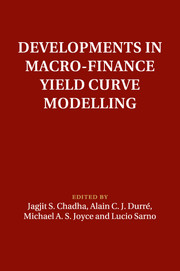Book contents
- Frontmatter
- Contents
- List of figures
- List of tables
- List of contributors
- Foreword
- Preface
- 1 Editors' introductory chapter and overview
- Part I Keynote addresses
- Part II New techniques
- 6 Compound autoregressive processes and defaultable bond pricing
- 7 Yield curve dimensionality when short rates are near the zero lower bound
- 8 The intelligible factor model: international comparison and stylized facts
- 9 Estimating the policy rule from money market rates when target rate changes are lumpy
- 10 Developing a practical yield curve model: an odyssey
- Part III Policy
- Part IV Estimating inflation risk
- Part V Default risk
- Index
10 - Developing a practical yield curve model: an odyssey
from Part II - New techniques
Published online by Cambridge University Press: 05 February 2014
- Frontmatter
- Contents
- List of figures
- List of tables
- List of contributors
- Foreword
- Preface
- 1 Editors' introductory chapter and overview
- Part I Keynote addresses
- Part II New techniques
- 6 Compound autoregressive processes and defaultable bond pricing
- 7 Yield curve dimensionality when short rates are near the zero lower bound
- 8 The intelligible factor model: international comparison and stylized facts
- 9 Estimating the policy rule from money market rates when target rate changes are lumpy
- 10 Developing a practical yield curve model: an odyssey
- Part III Policy
- Part IV Estimating inflation risk
- Part V Default risk
- Index
Summary
10.1 Introduction and background
What happens if one wishes to implement an interest rate model based on current knowledge about the subject? Current knowledge means here state of the art or best practice, but not cutting edge. What would some-one familiar with the recent literature and current practice be led to? The purpose of this chapter is to identify and describe the challenges presented by such an exercise.
The background of the exercise is the creation of a new global capital markets econometric model taking account of current developments, but in the spirit of earlier models developed for various financial services institutions; see, for example, Mulvey and Thorlacious (1998)(Towers Perrin), Dempster and Thorlacious (1998) (Swiss Re), Dempster and Arbeleche Grela (2003) (UniCredit) and the models currently in use by leading actuarial consultants. The emphasis in these ‘economic scenario generators’ is on their ability to be simulated forward over long horizons for pricing various financial products (Dempster et al., 2010), providing investment advice (Medova et al., 2008) and asset-liability management (Dempster et al., 2003). Since the pioneering system described in Mulvey and Thorlacious (1998), the keys to accurate scenario generation from these models are the yield curve models which forecast interest rates in each currency and upon which the determination of all other variables depend.
An immediate first question is what is meant by an interest rate model. Clearly the term covers many different creatures and so we will first describe some requirements for the exercise.
- Type
- Chapter
- Information
- Developments in Macro-Finance Yield Curve Modelling , pp. 251 - 290Publisher: Cambridge University PressPrint publication year: 2014
- 5
- Cited by



